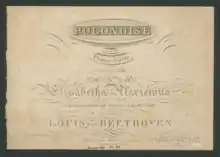Polonaise, Op. 89 (Beethoven)
The Polonaise in C major, Op. 89, by Ludwig van Beethoven is a polonaise for solo piano, published in 1815. He composed it in December 1814, at a time when the polonaise was becoming a popular dance and class marker among the European nobility.[1] Beethoven was presented as a prominent artist at the ongoing Congress of Vienna,[2] where he met the visiting Russian Empress Elizabeth Alexeievna. He dedicated the polonaise to the Empress, and was compensated with a sum of 50 ducats.[3] The piece is Beethoven's first and only published standalone polonaise, and is notable as a precursor to Chopin's more well-known polonaises.[4]

Structure
The piece is marked Alla Polacca, vivace (as a polonaise, lively). After four measures, there is a brief barless passage of ascending and descending scales moving to adagio (slow) and then to più presto (faster). At the conclusion of this unusual introduction, the piece returns to the first tempo and meter, and the polonaise rhythm and main theme are introduced.[5] The piece ends with a lengthy coda.[6] It takes about five minutes to perform.[7]
References
- Lodes, Birgit (Fall–Winter 2010). ""Le congrès danse": Set Form and Improvisation in Beethoven's Polonaise for Piano, Op. 89". The Musical Quarterly. 93: 415–418. doi:10.1093/musqtl/gdq022. JSTOR 41060778.
- Lockwood, Lewis (2003). Beethoven: The Music and the Life. New York; London: Norton. pp. 335. ISBN 0393050815.
- Cooper, Barry (2008). Beethoven. Oxford: Oxford University Press. p. 252. ISBN 0195313313.
- Hinson, Maurice (2014). Guide to the Pianist's Repertoire (Fourth ed.). Bloomington, IN: Indiana Univ. Press. pp. 125. ISBN 0253010225.
- Lodes, Birgit (Fall–Winter 2010). ""Le congrès danse": Set Form and Improvisation in Beethoven's Polonaise for Piano, Op. 89". The Musical Quarterly. 93: 424–427. doi:10.1093/musqtl/gdq022. JSTOR 41060778.
- Lodes, Birgit (Fall–Winter 2010). ""Le congrès danse": Set Form and Improvisation in Beethoven's Polonaise for Piano, Op. 89". The Musical Quarterly. 93: 433–434. doi:10.1093/musqtl/gdq022. JSTOR 41060778.
- Dubal, David (2004). The Art of the Piano: Its Performers, Literature, and Recordings. Pompton Plains, NJ: Amadeus Press. pp. 427. ISBN 1574670883.